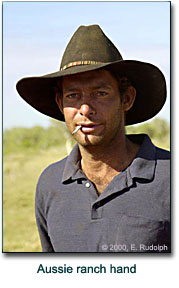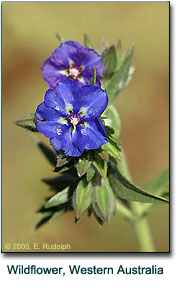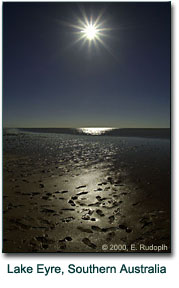|
|
 Camera Review... Nikon D1 Digital Camera
Text and Photography Copyright Dr. Ellen K. Rudolph
I have been using the Nikon D1 in the Australian Outback for almost three months now. Without reservation I give it a 4-star rating. This is one fantastic camera! It looks so much like the Nikon F5 body that I have had to put a white label on the top of the viewfinder so as not to confuse it with the F5, as I often use both systems simultaneously. The D1 also handles and performs exactly like the F5 - a definite plus for the experienced F5 user. The D1 is a sophisticated digital camera, designed primarily for the professional Nikon shooter with a collection of D-type AF Nikkor lenses to use with it. It is a pricey system, more than double the cost of the F5 when you add in all the needed accessories, but it puts superb digital technology into our hands that just a year ago was financially out of reach for mostusers. Essentials for the Field You will need a few essential accessories when you bring the D1 into the field with you, and this is where the costs can add up. The D1 uses rechargeable EN-4 Ni-MH battery packs. One pack lasts for a full day of shooting at HIGH (CbCr) resolution, so I recommend that you have at least two EN-4 batteries with you. This allows you to fill four 96 megabyte compact flashcards with 18 high resolution images each. If you recharge a battery pack every night you will always have a fresh one available to you. The D1 ships with a type B BriteView focusing screen but a type E clear matte Fresnel screen, with the architectural grid, is also available for it. This I also highly recommend. The other accessory that is crucial for ease of use in the field is the Microtech multimedia reader. There are generic readers available but this USB plug and play reader (with software for both Mac and PC), performs flawlessly. I cannot recommend it more highly.
I have learned to use the D1 judiciously -- that is, I immediately delete the images that I know are faulty (rarely!), and I also try not to take redundant images that just consume space on the flashcard. Shooting at HIGH (CbCr TIFF) resolution automatically makes you conserve, as the D1 needs time to resolve the image before you can take the next image. This is good. It forces you to be conservative. You can, of course, shoot at much lower resolutions if outputting to print is not your goal. Using lower resolutions, you can store many more images per flashcard. At FINE resolution, for example, you can store 66 .jpg images per 96MB card; at NORMAL you store 132 .jpg images per card; and at BASIC (approx. 320KB) you can store 265 .jpg images per card. To get the most from the D1, use D-type AF Nikkor lenses. Wide angles are somewhat lost on the D1 as it transforms a 20mm lens into a 35mm. About the only lens I don't use with this body is the 16mm fisheye. Under Technical Notes I have listed the lenses which cannot be used with the D1. LCD and Other Precautions You can use the LCD monitor on the camera to review your images but be mindful that this uses a lot of precious battery space, so do it sparingly when you don't have good battery backup. Under normal shooting conditions I almost never review images via the LCD monitor, except perhaps to give someone a quick peek at an image. You will know that the current image has been fully resolved when the LCD icon stops blinking. It is therefore not exactly spontaneous shooting when you are shooting at high resolution with the D1. It is worth shooting in this mode however since each image downloads a 7.5 megabyte .tif file @ 300 dpi. I save the master .tif files to zip disks (yes, I wish I had a CD-RW with me) and I just make 72 dpi .jpgs from them for later web site use. 
For me, the D1 serves as the digital equivalent of taking an evaluative Polaroid and so I often check the LCD monitor in contrasty or otherwise challenging shooting environments, despite battery constraints. In such situations I will take a digital shot first and evaluate its effects before shooting the same scene with film. This saves on film, of course, but more importantly it lets me see clearly the pros and cons of the particular perspective and/or lens that I have chosen to use under the circumstances. This is an extremely helpful option to have available to me in the field. Beware: If the D1 is in the process of writing a file to the CompactFlash card, and the power switch is turned off (intentionally or unintentionally), the camera's operating system will keep the power on until the writing process is finished for the one frame that is being written. After recording the current frame, the power will turn off. All other frames remaining in the buffer will be lost. Also, when you remove a CompactFlash card from the camera, you must be certain that the camera is turned off first. Removing the card while data are being recorded will not only result in the current frame being lost, but it could also cause irreparable damage to the camera or the card. Flash with the D1 The D1 can be used with the SB-28DX (available separately) for sophisticated flash photography using the D1's unique 3D multi-sensor balanced fill-flash control. TTL mode, however, is only available when the SB-28DX is attached. If I have any complaints at all about the D1 it has to do with this flash. For one, the SB-28DX has no standard outlet for my Quantum Turbo battery packs. Unfortunately, I was not aware of this incompatibility when I brought the D1 into the field with me. The DX flash seems to be quite hot to me when review its effects on the computer although that may be a function of the particular custom settings that I have set on the D1-- that remains to be seen. I am limited, also, to using the SB-28DX on the D1, as the D1 does not allow the use of other flash systems even though I can use the DX with my F5's. At any rate, the D1's ability to use available light is so good that I tend to use flash sparingly with it. Other Goodies A great thing is that you can change the ISO of your digital media at whim. You can boost the ISO from 200 to 1600 ISO per image, depending upon the shooting environment. I have found, however, that shooting at ISO 200 is optimal even in less than optimal light conditions. Of course, you can change ISO settings on some of the more consumer-oriented digital bodies on the market today, as well. But in the hands of a professional shooter this function on the D1 can make or break a low-light shot. For example, here in the Australian Outback, where most of the wildlife is nocturnal rather than diurnal, the D1 can get the shot when the F5 cannot - - such as when we are spotting wildlife at night. Flash with an F5 sometimes just can't get enough light on a moving target to focus properly. This can be highly frustrating. I have shots of rare and endangered mammals that I simply couldn't have gotten except with the use of the D1 in combination with its SB28-DX flash. Our Australia web site (www.2DocStock.com) is filled with D1 images. Just remember that these Nikon D1 images have been reduced and compressed into small JPEGS files for ease of downloading to your computer. Bravo NIKON, this is one great camera system! Technical Notes
Dr. Ellen K. Rudolph |
|
|
 Posting from Darwin, in the Northern Territory, Australia.
Posting from Darwin, in the Northern Territory, Australia. User Notes
User Notes